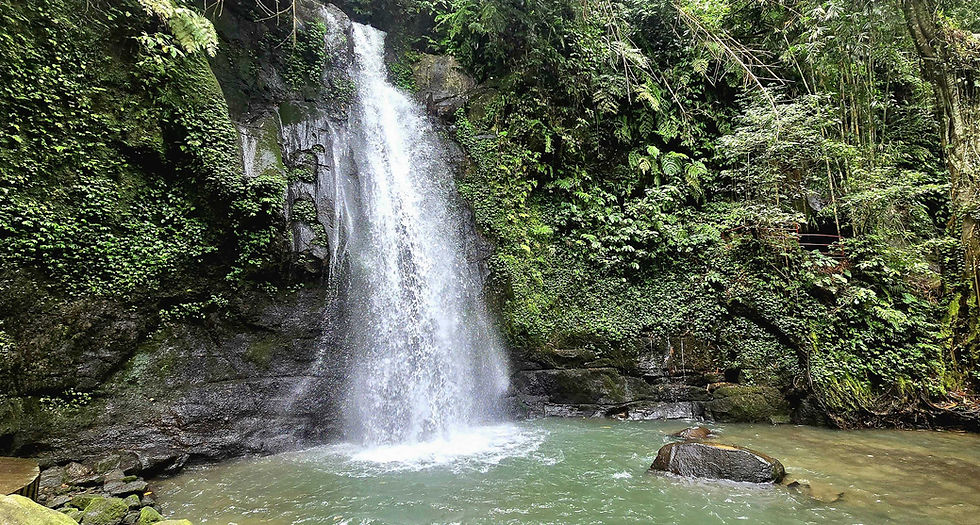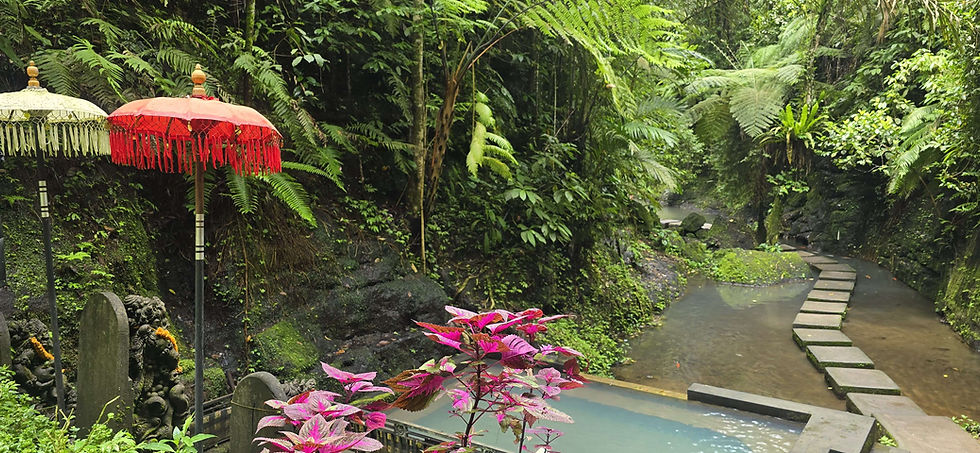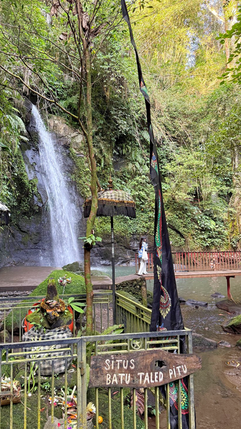Ulu Petanu Waterfall
- Shannon
- Sep 16
- 4 min read
The Sacred Waters of Ulu Petanu
Hidden deep within the village of Tegallalang, which is renowned for its iconic rice terraces, Ulu Petanu Waterfall remains a peaceful retreat far removed from Bali’s more commercialised sites. Unlike its popular counterparts, this secluded spot offers a meditative atmosphere, surrounded by dense jungle and the soft roar of cascading water. The waterfall stands about 15 metres high, not towering but this modest scale allows for a more intimate experience. The natural pool at its base shimmers with crystal clear water, offering visitors a chance to cool off in serene surroundings. It’s a place that feels untouched, a genuine escape from the noise of modern life.

Yet Ulu Petanu is more than just a scenic stop, it’s a spiritual site woven into Bali’s rich web of myth and ritual. Upon arrival, you descend 90 stone steps that mark the start of a deeper journey. The first destination is Tirta Waledan Pancoran Tiga Rasa, a sacred spring used for melukat, a Balinese purification ceremony believed to cleanse the body, mind and soul of negative energies. Locals and spiritual seekers visit regularly to partake in the ritual, letting the holy water restore inner balance in a setting alive with natural energy. Waterfalls across Bali are seen as places where the spiritual and physical worlds meet and Ulu Petanu offers a chance to witness that belief in practice.
The waterfall lies near the junction of three rivers, Petanu, Pakerisan and Woos, forming a triangle considered sacred in Balinese cosmology. This configuration is believed to represent Purusa or pure consciousness, a core concept in Hindu philosophy. It’s not just geography, it’s symbolism written into the land itself. The surrounding jungle, the flow of the rivers and the tranquil sounds of nature all add to the site’s deep spiritual charge, making it ideal for both meditation and ritual.

Ulu Petanu is deeply rooted in Balinese mythology, tied to the ancient legend of King Mayadenaw, a powerful and malevolent ruler who saw himself as a god and demanded worship, wreaking havoc by destroying Hindu temples and forbidding prayer. In response to the people's pleas, Lord Indra, the God of War, descended from the heavens to wage a fierce battle against Mayadenawa in the area now known as Tampaksiring, named after the king’s slanted footprints. The cunning king poisoned the spring that sustained Indra’s army but Indra struck the rock beneath his feet, creating a new holy spring, today’s Tirta Empul Temple, whose waters healed his followers. Eventually, Mayadenawa was defeated and as he fell, his blood flowed into the Petanu River, cursing its waters and the surrounding land, causing the river to run red and crops to fail. In response, villagers began purification rituals at Ulu Petanu Waterfall to cleanse the tainted river and restore balance, marking the site as a sacred place where ritual, memory and reverence for the divine continue to quietly shape the landscape.
The temple near the waterfall remains a vital spiritual hub for local villagers, who regularly bring offerings and hold traditional ceremonies that connect modern practice to ancient beliefs. Oral histories warn that disrespecting the water spirit said to dwell within the falls can bring misfortune, underscoring the protective role this spirit plays in maintaining nature’s balance. This presence transforms a visit to Ulu Petanu from a simple nature walk into a profound encounter with the sacred. Even now, water blessings continue beneath the cascade, honouring both the enduring power of nature and the cautionary lessons of the Mayadenawa legend, a timeless reminder of the consequences when the sacred order is disturbed.

🗺️ Location
Jalan Raya Bayad, Kedisan, Tegallalang, Gianyar Regency, Bali, Indonesia
🚆 How to get there
The easiest and most affordable way I found to reach the falls was by hiring a private GoJek scooter rider from Ubud. The ride took around 35 minutes, winding through scenic villages and rice fields before arriving at the trailhead. From there, it’s an easy 10 - 15 minute walk down a well maintained path that cuts through dense Bali jungle. A riverside trail leads you across a small bridge and straight to the base of the falls. If you’re waterfall hopping, I booked a half-day tour to four different spots in the area for about 250000 IDR, great value for a full morning of exploring. The area is dotted with stunning waterfalls like Tibumana, Goa Reng Rang and Kanto Lampo, to name just a few.
⭐ Attraction Info
The falls are open daily (except on Nyepi Day) between 8am - 6pm. Entry costs 30000 IDR but be sure to bring cash as there are no ATMs nearby. For the best experience, aim to visit early in the morning or late in the afternoon when the light is softer and the crowds thinner. During the rainy season (November to March), the waterfall is especially powerful and dramatic. Swimming is completely safe here, so pack a towel and a change of clothes.
























